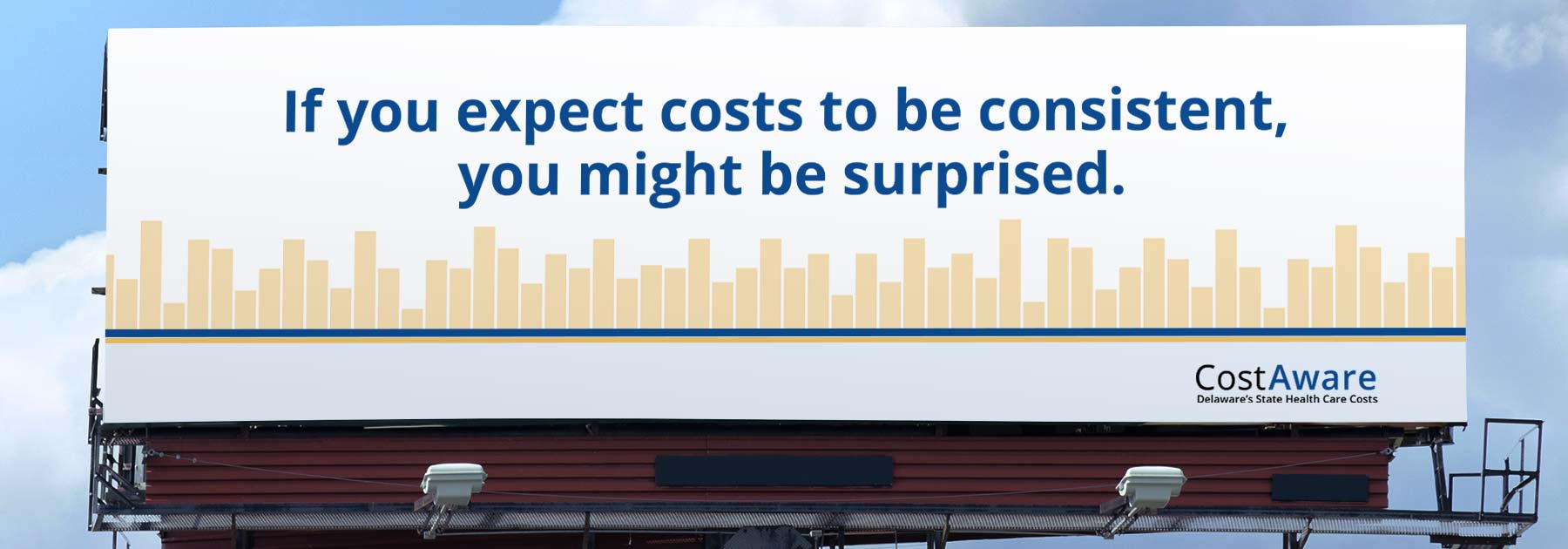Frequently Asked Questions
About the Website
- What is the purpose of this website? The CostAware website is how the Delaware Health Care Commission (DHCC) will share its assessments of Delaware’s health care systems. It will share comparisons of health care activity, costs and outcomes for health care services, providers, and programs. These findings are intended to inform collaborative initiatives and programs among health care providers that will promote access to high-quality affordable care.
- How can the information be used? CostAware webpages are expected to increase awareness of Delaware’s health care variations in cost and quality. As CostAware reports are developed, they will provide information that allows consumers, employers, and other purchasers of health care to make informed decisions about where to seek health care that meets their needs.
- Who developed the website? The CostAware website was developed by the Delaware Health Care Commission (DHCC) and the Department of Health and Social Services (DHSS).
- Are the costs for Delaware hospitals only? Currently, yes. DHCC and DHIN are exploring options for providing similar information for hospitals located in neighboring states in future versions of CostAware.
Frequently Used Terms
- What is the difference between the APCD and the DHIN? Delaware Health Information Network (DHIN) is the State-sanctioned Health Information Exchange (HIE) and manages the Health Care Claims Database (HCCD). The HCCD is Delaware’s name for what is often identified as an All-Payer Claims Database (APCD) in other states.
- What is an Accountable Care Organization (ACO)? ACOs are groups of doctors, hospitals, and other health care providers, who come together voluntarily to provide coordinated high-quality care to their patients. ACOs establish financial incentives for providers to promote best practice care to the right persons at the right time while improving patients’ overall health care experiences. The ACO initiative is a major piece in Delaware’s Road to Value – a plan to transform the way that health care is delivered and paid for in the state. For more information on the Road to Value, visit: https://www.choosehealthde.com/Road-to-Value.
- What are CPT codes? Current Procedural Terminology (CPT) codes are developed and maintained by the American Medical Association (AMA). These codes identify and categorize medical procedures performed by any provider.
- What are MS-DRGs? Medicare Severity Diagnosis Related Groups (MS-DRGs) are used to categorize patients with similar clinical characteristics who have received similar health care services. Payment amounts are sometimes determined by the MS-DRG. MS-DRGs can be used to compare costs across health systems, regions, and states in a meaningful way.
About the Methodology
- What is the data source? The Delaware Health Care Claims Database (HCCD), maintained by Delaware Health Information Network (DHIN). This database is a collection of claims data from Medicare, Medicaid and commercial health insurers and is the largest repository of claims data in the state. For more information about the HCCD, visit: https://dhin.org/healthcare-claims-database/
- Why do prices differ across hospitals and providers? Many factors contribute to price variation including differences in clinical practice, billing practices, contractual relationships between payers and providers and payment systems used by health insurers.
- Why are the Total Cost of Care (TCOC) measures grouped by ACO? ACO groupings were chosen to be consistent with the CMS quality measures displayed on the CostAware website. CMS reports this data by ACO. It is anticipated that future versions of CostAware will include more detailed cost, utilization, and quality information.
Charts not working?
Web browser privacy and third-party cookie rules can sometimes affect the display and functionality of embed charts. Please check your security and privacy settings and adjust accordingly.
Instructions for enabling third-party cookies.
Or try browsing the charts directly on the Delaware Health Care Claims Database, powered by DHIN, at dhin.org.
Resources
- Stakeholder Webinar – In August of 2023, representatives from DHSS, DHIN, and Freedman HealthCare (FHC) hosted a series of webinars to review the data and study methodology for imaging procedures and provide an opportunity for provider stakeholders named in the reports to participate in Q&A. A recording of the third and final CostAware Stakeholder Engagement webinar is available at this link: https://youtu.be/Qgip0WkKrbI
Background: In 2022, the Delaware Health Care Commission (DHCC) introduced CostAware, a website designed to help consumers understand how their healthcare dollars are spent by comparing variation in costs for different episodes of care and medical services based on actual medical claims in Delaware. The analyses leverage data in the Delaware Health Care Claims Database (HCCD), managed by DHIN, and will be used by DHCC to inform and support a variety of policy initiatives. - Delaware Spending and Quality Benchmarks – This initiative continues our movement along the State’s “Road to Value” and is deeply rooted in our steadfast efforts to improve access to affordable, quality health care for all Delawareans. In late 2018, Governor John Carney signed Executive Order 25, establishing a state health care spending benchmark, a per-annum rate-of-growth benchmark for health care spending, and several health care quality measures. The first spending benchmark went into effect on Jan. 1, 2019, and was set at 3.8%, with the target expected to decrease gradually to 3% over the following three years. For more information about the benchmarks, visit: https://dhss.delaware.gov/dhss/dhcc/global.html
- Benchmark Trend Report – The Benchmark Trend Report details total health care spending for Calendar Year 2020 and compares it to data collected for Calendar Years 2018 & 2019. For a copy of the report, visit: https://dhss.delaware.gov/dhcc/files/benchmarktrendreport2020.pdf.
- Road to Value – Delaware spends more on health care per person than most states. See new strategies in place that will help slow the growth of health care spending, improve outcomes, and transform how you receive care: https://www.choosehealthde.com/Road-to-Value.
- Choose Health Delaware – The State of Delaware’s free official program that helps individuals and businesses learn more about the low-cost, high-quality health coverage available through the Health Insurance Marketplace. Choose Health Delaware is not an insurance company, however, through the program’s website (https://www.choosehealthde.com/Health-Insurance-Marketplace) you can see what Delaware’s partner health insurance company, Highmark Blue Cross Blue Shield Delaware, can offer you and how you might be able to lower your health insurance costs.






